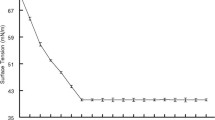Abstract
Novel strategies toward the use of low-cost media to produce food-grade microbial products have been considerably attended in recent years. In this study, date syrup obtained from low-quality date fruits was implemented for biosurfactant production by the probiotic bacterium, Lactobacillus rhamnosus PTCC 1637. The most level of biosurfactant was achieved through fermentation in a bioreactor with a lactose feeding phase, up to 24 h. Critical micelle concentration of the cell-bound biosurfactant was found to be 6.0 mg/ml with a minimum surface tension value of 39.00 mN/m and a maximum emulsifying index of 42%. The spectrum of Fourier transform infrared spectroscopy taken from the cell-bound biosurfactant suggests that it should be a multi-component mixture of protein and polysaccharides associated with phosphate groups. The results indicated the potential for developing strategies toward the low-cost production of food-grade biomaterials by probiotic microorganisms.




Similar content being viewed by others
Change history
12 June 2018
In the original version of these 14 articles the reference list was unfortunately not represented according to the journal’s new bibliographical style, which should have been implemented from January 2018.
References
Al-Farsi M, Alasalvar C, Morris A, Baron M, Shahidi F. Compositional and sensory characteristics of three native sun-dried date (Phoenix dactylifera L.) varieties grown in Oman. J. Agric. Food Chem. 53:7586–7591 (2005).
Al-Shahib W, Marshall RJ. The fruit of the date palm: its possible use as the best food for the future? Int. J. Food Sci. Nutr. 54:247–259 (2003).
Banat IM, Franzetti A, Gandolfi I, Bestetti G, Martinotti MG, Fracchia L, Smyth TJ, Marchant R. Microbial biosurfactants production, applications and future potential. Appl. Microbiol. Biotechnol. 87:427–444 (2010).
Batish V, Lal R, Chander H. Effect of nutritional factors on the production of antifungal substance by Lactococcus lactis subsp. lactis biovar diacetylactis. Aust. J. Dairy Technol. 45:74–76 (1990).
Brzozowski B, Bednarski W, Golek P. The adhesive capability of two Lactobacillus strains and physicochemical properties of their synthesized biosurfactants. Food Technol. Biotechnol. 49:177 (2011).
Cameotra SS, Makkar RS, Kaur J, Mehta S. Synthesis of biosurfactants and their advantages to microorganisms and mankind. In: Biosurfactants. Springer, pp 261–280 (2010).
Desai JD, Banat IM. Microbial production of surfactants and their commercial potential. Microbiol. Mol. Biol. Rev. 61:47–64 (1997).
Fernandes ECR. Study of biosurfactant “cocktails” with enhanced properties. Diss. (2013).
Fernandes PAV, Arruda IRd, Santos AFABd, Araújo AAd, Maior AMS, Ximenes EA. Antimicrobial activity of surfactants produced by Bacillus subtilis R14 against multidrug-resistant bacteria. Braz. J. Microbiol. 38:704–709 (2007).
Fontes GC, Amaral F, Filomena P, Nele M, Coelho Z, Alice M. Factorial design to optimize biosurfactant production by Yarrowia lipolytica. BioMed. Res. Int. 1–8 (2010).
Ghribi D, Ellouze-Chaabouni S. Enhancement of Bacillus subtilis lipopeptide biosurfactants production through optimization of medium composition and adequate control of aeration. Biotechnol. Res. Int. 2011:1–6 (2011). https://doi.org/10.4061/2011/653654.
Gudiña E, Teixeira J, Rodrigues L. Biosurfactant-producing Lactobacilli: Screening, production profiles, and effect of medium composition. Appl. Environ. Soil Sci. 10: 1155 (2011).
Hofvendahl K, Hahn–Hägerdal B. Factors affecting the fermentative lactic acid production from renewable resources. Enzyme Microb. Technol. 26:87–107 (2000).
Horwitz W. Official methods of analysis of the AOAC International. No. C/630.240 O3/2000 (2000).
Hospinal M, Martínez D, Valladares K, Gutierrez S, Merino F. Effect of carbon/nitrogen and carbon/phosphorus ratio on the production of rhamnolipid biosurfactant by pseudomonas aeruginosa 6k11 isolated from soil contaminated with oil. p. 1–8 (2015).
Jensen PR, Hammer K. Minimal requirements for exponential growth of Lactococcus lactis. Appl. Environ. Microbiol. 59:4363–4366 (1993).
Maneerat S. Production of biosurfactants using substrates from renewable-resources. Songklanakarin J. Sci. Technol. 27:675–683 (2005).
Moldes AB, Torrado AM, Barral MT, Domínguez JM. Evaluation of biosurfactant production from various agricultural residues by Lactobacillus pentosus. J. Agric. Food Chem. 55:4481–4486 (2007).
Moosavi-Nasab M, Layegh B, Aminlari L, Hashemi MB. Microbial production of levan using date syrup and investigation of its properties. World Acad. Sci. Eng. Technol. 44:1248–1254 (2010).
Moosavi-Nasab M, Shekaripour F, Alipoor M. Use of date syrup as agricultural waste for xanthan production by Xanthomonas campestris. Iran Agric. Res. 27:89–98 (2010).
Moosavi-Nasab M, Taherian AR, Bakhtiyari M, Farahnaky A, Askari H. Structural and rheological properties of succinoglycan biogums made from low-quality date syrup or sucrose using agrobacterium radiobacter inoculation. Food Bioprocess Technol. 5:638–647 (2012).
Mostafazadeh AK, Sarshar M, Javadian S, Zarefard M, Haghighi ZA. Separation of fructose and glucose from date syrup using resin chromatographic method: Experimental data and mathematical modeling. Sep. Purif. Technol. 79:72–78 (2011).
Onur G. Screening of biosurfactant producing and diesel oil degrading bacteria from petroleum hydrocarbon contaminated surface waters. Dissertation, Middle East Technical University. Diss. (2015).
Rivera OMP, Moldes AB, Torrado AM, Domínguez JM. Lactic acid and biosurfactants production from hydrolyzed distilled grape marc. Process Biochem. 42:1010–1020 (2007).
Rodrigues L, Teixeira J, Oliveira R. Low-cost fermentative medium for biosurfactant production by probiotic bacteria. Biochem. Eng. J. 32:135–142 (2006).
Rodrigues L, Teixeira J, Oliveira R, Van Der Mei HC. Response surface optimization of the medium components for the production of biosurfactants by probiotic bacteria. Process Biochem. 41:1–10 (2006).
Santa Anna L, Sebastian G, Menezes E, Alves T, Santos A, Pereira Jr N, Freire D. Production of biosurfactants from Pseudomonas aeruginosa PA 1 isolated in oil environments. Braz. J. Chem. Eng. 19:159–166 (2002).
Schillinger U. Isolation and identification of lactobacilli from novel-type probiotic and mild yoghurts and their stability during refrigerated storage. Int. J. Food Microbiol. 47:79–87 (1999).
Van Hamme JD, Singh A, Ward OP. Physiological aspects: Part 1 in a series of papers devoted to surfactants in microbiology and biotechnology. Biotechnol. Adv. 24:604–620 (2006).
Velraeds MM, van der Mei HC, Reid G, Busscher HJ. Physicochemical and biochemical characterization of biosurfactants released by Lactobacillus strains. Colloids Surf., B 8:51–61 (1996).
Acknowledgements
This work was supported by Shiraz University Grant No. GR-56 (Shiraz, Iran).
Author information
Authors and Affiliations
Corresponding author
Rights and permissions
About this article
Cite this article
Ghasemi, A., Moosavi-Nasab, M., Behzadnia, A. et al. Enhanced biosurfactant production with low-quality date syrup by Lactobacillus rhamnosus using a fed-batch fermentation. Food Sci Biotechnol 27, 1137–1144 (2018). https://doi.org/10.1007/s10068-018-0366-5
Received:
Revised:
Accepted:
Published:
Issue Date:
DOI: https://doi.org/10.1007/s10068-018-0366-5




